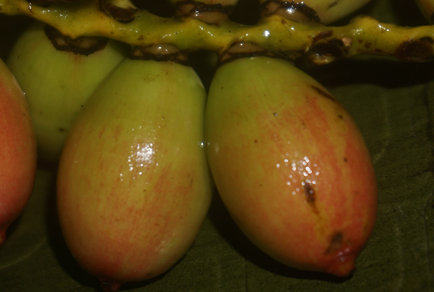Abstract
A new mottled-leaved species of Pinanga, P. curioi, is described from Panay Island, Philippines. This species exhibits an admixture of morphological traits of the Maculata group, but can be circumscribed with the following combination of characters: abaxially subglaucescent subfalcate-sigmoid middle leaflets with an inconspicuously narrowed base and non-pendulous shallow apical incisions, 3–5 greenish to orangish yellow rachillae, each bearing large obovoid-ellipsoid fruits which are only distally or partially spirally-arranged, and an elongate embryo. Relevant morphological and ecological notes and an updated key for the Maculata group are also included. P. curioi is endemic to Panay Island and exhibits the least mottling in the group when fully matured. It is hereby assessed as Endangered following the IUCN guidelines.
References
- Adorador, J.T., Meneses, Z.D. & Fernando, E.S. (2020) Pinanga gruezoi (Arecaceae), a new slender clustering palm from the Philippines with notes on an amended description of P. samarana. Phytotaxa 429 (2): 120–134. https://doi.org/10.11646/phytotaxa.429.2.3
- Alejandro, G.J., Meve, U. & Vliede-Schumann, S. (2008) Two new species of Mussaenda (Rubiaceae) from Panay Island, Philippines, Botanical Journal of the Linnean Society 158 (1): 87–92. https://doi.org/10.1111/j.1095-8339.2008.00882.x
- America, L.C. (2000) Conservation biology of Pinanga bicolana Fernando (Arecaceae: Arecoideae) in the Bicol National Park. Phd Thesis. University of the Philippines Los Baños, 117 pp.
- Beccari, O. (1907) Notes on Philippine palms, I. Philippine Journal of Science (Botany) 2: 219–240.
- Beccari, O. (1919) The palms of the Philippine Islands. Philippine Journal of Science (Botany) 14: 295–359.
- Bachman, S., Moat, J., Hill, A., de la Torre, J. & Scott, B. (2011) Supporting Red List threat assessment with GeoCAT: Geospatial conservation assessment tool. Zookeys 150: 117–126. https://doi.org/10.3897/zookeys.150.2109
- Dalisay, J.A.G., Naive, M.A.K., Bancaya, P.S. & Sangvirotjanapat, S. (2022) Globba philippinensis (Zingiberaceae), a new endemic species from Western Visayas, Philippines. Taiwania 67: 25–29.
- Fernando, E.S. (1988) The mottled–leaved species of Pinanga in the Philippines. Principes 32 (4): 165–174.
- Fernando, E.S. (1990) A preliminary analysis of the palm flora of the Philippine islands. Principes 34 (1): 28–45.
- Gaulke, M. & Curio, E. (2000) A new monitor lizard from Panay Island, Philippines. Spixiana (24): 275–286.
- Heaney, L.R. (1986) Biogeography of mammals in SE Asia: estimates of rates of colonization, extinction, and speciation. Biological Journal of the Linnean Society 28: 127–165. https://doi.org/10.1111/j.1095-8312.1986.tb01752.x
- Hornbill Specialist Group (2020) Hornbill Natural History and Conservation 1 (2): 1–65.
- IUCN (2012) IUCN Red List Categories and Criteria. Version 3.1, (2nd edn). Gland and Cambridge, 32 pp.
- IUCN Standards and Petitions Subcommittee (2019) Guidelines for Using the IUCN Red List Categories and Criteria, Version 14. Prepared by the Standards and Petitions Subcommittee.
- Key Biodiversity Areas Partnership (2023) Key Biodiversity Areas factsheet: Central Panay mountains. Extracted from the World Database of Key Biodiversity Areas. 2023. [https://www.keybiodiversityareas.org/site/factsheet/9761]
- Lemaire, C. (1863) Pinanga maculata. L’Illustration Horticole 10: pl. 361.
- Mayr, E. (2000) The biological species concept. In: Wheeler, Q.D. & Meier, E. (Eds.) Species concepts and phylogenetic theory: a debate. Columbia University Press, New York, pp. 17–29.
- Ong, P.S., Afuang, L.E. & Rosell-Ambal, R.G. (Eds.) (2002) Philippine Biodiversity Conservation Priorities: A Second Iteration of the National Biodiversity Strategy and Action Plan. DENR-PAWB, CIP, UP-CIDS, FPE. Quezon City.
- Pelser, P.B., Barcelona, J.F. & Nickrent, D.L. (Eds.) (2011 onwards) Co’s Digital Flora of the Philippines. Available from: https://www.philippineplants.org/ (accessed 30 September 2021)
- Peng, C.I, Rubite, R.R., Lin, C.-W., Hughes, M., Kono, Y. & Chung, K.-F. (2017) Three new species of Begonia sect. Baryandra from Panay Island, Philippines. Botanical Studies 58: 28. https://doi.org/10.1186/s40529-017-0182-x
- van Steenis-Kruseman, M.J. & van Steenis, C.G.G.J. (1950). Malaysian plant collectors and collections being a Cyclopaedia of botanical exploration in Malaysia and a guide to the concerned literature up to the year 1950. Flora Malesiana - Series 1, Spermatophyta 1 (1): 2–639.
- Thiers, B. (2015-continuously updated) Index Herbariorum: A Global Directory of Public Herbaria and Associated Staff. New York otanical Garden’s Virtual Herbarium. [http://sweetgum.nybg.org/ih]
- Yumul, G.P.Jr., Dimalanta, C.B., Mrquez, E.J. & Queaño, K.L. (2009) Onland signatures of the Palawan microcontinental block and Philippine mobile belt collision and crustal growth process: A review. Journal of Asian Earth Sciences 34: 610–623. https://doi.org/10.1016/j.jseaes.2008.10.002


